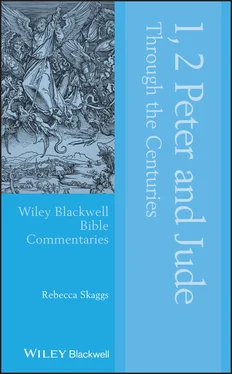Hence, it is a joyful undertaking to trace the reception history of 1 Peter (words addressed to sufferers of all time; words of encouragement, hope, and joy); Jude (one of the most intriguing examples of the use of visual imagery in argument); and 2 Peter (the most extensive discussion of the end of the world by fire). In spite of the ambiguities surrounding their origins, readers have received and been profoundly affected by each of them, albeit in different ways through the centuries.
Historical Overview and Genre
A key component in the reception history of a text is the understanding of how it has been perceived over time in terms of its genre and themes. Jauss (1982: 174) calls this the “horizons of expectation,” which are formed by a community’s pre‐understanding of a genre. For example, were these texts (1, 2 Peter and Jude) considered to be apostolic, part of the canon of scripture? Were they viewed as letters? Sermons? Reception history sheds some light on these issues.
These three little epistles belong to a group of early church writings known from ancient times as the General or Catholic epistles: as early as the third century, Origen and other church fathers refer to them as “general” or “universal” (Catholic), since they are not addressed to a specific church or person as are the Pauline epistles; for example, James is addressed to the “12 tribes of the dispersion” and 1 Peter is sent to “God’s elect scattered throughout various areas of Asia Minor.” 2 Peter and Jude are even more vague: “to those who have been called, the beloved of God” (Jude 1) and to those who have “received a faith as precious as ours” (2 Pet. 1:1). The Johannine epistles are cyclical letters sent to a series of churches in Ephesus. Although their authorship has been severely challenged through the years, they were still accepted and used in most of the churches (this will be treated in more detail later). In spite of these questions, their witness to the early church communities is significant because they provide a non‐Pauline perspective of the early beliefs and practices (Bray, 2000: xxi). Apparently, there was an early distinction made between these seven epistles – James; 1, 2 Peter; 1, 2, 3 John; and Jude – in regard to authenticity. Three of them were almost immediately accepted as authentically apostolic by the whole church: James, 1 Peter, and 1 John. Later, the other four were also recognized in the West and most of the East, although the Antiochene tradition temporarily resisted this trend. 2 Peter experienced the most severe challenges even continuing into current times.
The earliest and strongest source of this information is Eusebius of Caesarea (c.260–340). In his account of the life of James, he concludes with the statement, “Such is the story of James, to whom is attributed the first of the ‘general epistles’” ( HE 2.23.25). Later in the same document he categorizes early writings, stating, “Disputed books which are nevertheless familiar to most include the epistles known as James, Jude and 2 Peter, and those called 2 John and 3 John, the work of either of the Evangelist or someone else with the same name” ( HE 3.25, FC 19: 178: ccel.org). From this it can be implied with some amount of certainty that the two unmentioned epistles (1 Peter and 1 John) were generally accepted as authentically apostolic as named. Indeed, he says, “Of Peter one epistle, known as his first, is accepted, and this the early fathers quoted freely, as undoubtedly genuine, in their own writings” ( HE 3.3, FC 19: 139: ccel.org). Eusebius bases this idea on Polycarp of Smyrna’s (69–155) extensive use of 1 Peter in his epistle to the Philippians ( HE 3.14, FC 19: 233: ccel.org). This is especially important since Polycarp lived soon after the epistle was written. Hence, this general acceptance by the church allowed the early writers to use all of these texts freely as canonical scripture.
Although 2 Peter and Jude were more strongly contested, it is fairly clear that through the fourth century 1 Peter, along with James and 1 John, was accepted as authentic and was eventually included in the Antiochene canon. In fact, Jude was generally accepted through the second century as well (see Appendix 1for details). Even 2 Peter, although it was seriously challenged almost immediately on account of its obvious literary differences from 1 Peter, was often alluded to until it achieved a stronger standing after the second century (see Appendix 1).The questions that arose about Jude were primarily in regard to his use of the apocrypha. In light of this, then, there is little doubt that the early writers considered 1 Peter as part of the canon and used it as such; they viewed it as a letter written to defend the true faith against attacks by various heretics. In fact, all of these epistles were viewed as addressing issues and problems of the earliest Christian communities and were used in addressing the major theological controversies through the centuries.
In the medieval era, almost everyone generally acknowledges all seven Catholic epistles as authentic (e.g. Bede, Commentary on the Seven Catholic Epistles , 1985). However, during the time of the Renaissance and Reformation, doubts about all of the antilegomena resurfaced (see Erasmus, Karlstadt, and Cajetan, all who especially express doubts about 2 Peter and Jude, in Hayes, 2004: 143); Cajetan labels Jude as having secondary authority (Kelly, 1981: 223). Luther, however, strongly compliments 2 Peter, clearly recognizing Peter’s authorship of two epistles: “[2 Peter was] written [because] he saw how the true, pure doctrine of faith was being corrupted, obscured and suppressed” ( Commentary on Peter and Jude , 1990: 229). He saw Jude as apostolic, but inferior, however, since he considers that Jude merely copied 2 Peter; he also relegates it to the appendix of his September Testament (1522) (Luther, Comm ., 1990: 290; Kelly, 1981: 223). Calvin accepts 2 Peter’s authentic authorship, acknowledging Eusebius’s stated doubts but “[this] should not keep us from reading it.” He does agree that there are significant differences from 1 Peter’s style but states that ultimately, “It contains nothing unworthy of Peter” and “it shows throughout the power and grace of the apostolic spirit” (Calvin, 1963: 325). Calvin also includes Jude in his canon, listing it along with the other 66 books ( French Confession , art. 3, 1559).
On the other hand, Grotius ( Annotationes , 1650) attributes the differences between 1 and 2 Peter to different authors; that the author of 2 Peter may have been Simeon, the successor of James, the head of the Jerusalem Church. Bengel does not see a problem with the differences. Although he does acknowledge them, he states that, “The character of this epistle [2 Peter] remarkably agrees with the former [1 Peter], and with Peter’s speeches in Acts” (Bengel, 1981: 760). He locates Jude as following 2 Peter and remarks that the same way Peter quotes and confirms Paul, Jude quotes and confirms Peter (ibid.: 823); Wesley agrees with Bengel on Jude and also accepts its authenticity: “The parts of this epistle [were] written not long before St. Peter’s death and the destruction of Jerusalem, with the same design as the former” (WesleyCenter: ccel.org).
From the seventeenth to the nineteenth century, the origin and authenticity of 2 Peter continued to be ambiguous: challenged by some, defended by others. Even though most acknowledged the differences in style from 1 Peter, and the complications arising from the similarities and relation to Jude, most writers suggested alternatives that still maintained its authenticity. For example, Deist T. Sherlock (1678–1761) was an English bishop who was known for his apologetics. He argued that both Jude and 2 Peter used a no longer existent Jewish source (not Enoch) and an earlier writing that circulated in the church with the main theme of false teachers (see Hayes, 2004: 143–144 for details). In the case of Jude, many ancient writers as well as modern scholars accept its apostolic authorship but continue to express some doubts.
Читать дальше












